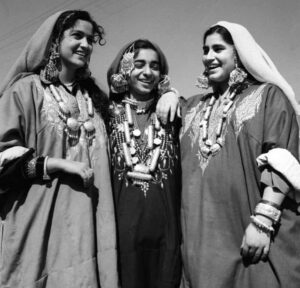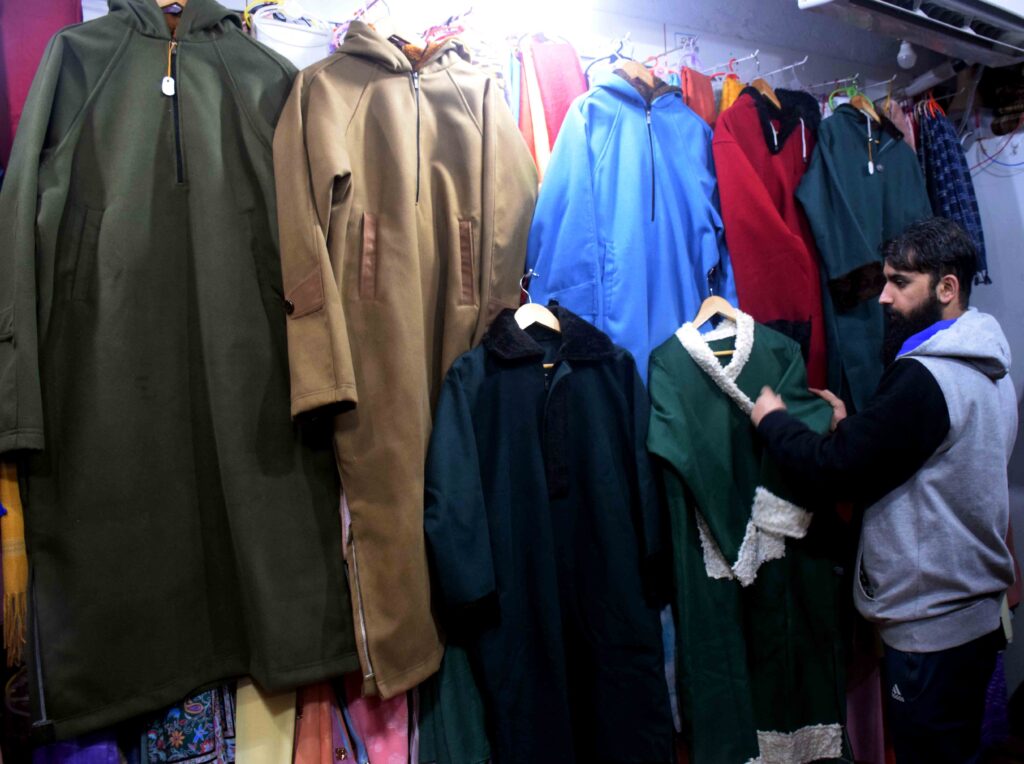December 21, winter solstice known as Chillai kalan in the Valley, has come to be celebrated as International Pheran Day over the last few years.
Jaspreet Kaur
Traditional clothing isn’t just a matter of style or tradition; it’s often deeply intertwined with emotions and feelings and is also an important reflection of a community’s cultural values and history. Clothes play a significant cultural role in creating a sense of belonging, unity and collective identity.
Occasionally, politics and conflict can lead to a revival of traditional dress, as can be seen with some Palestinian attire. Once upon a time, the now-symbolic keffiyeh was worn only by farmers for protection from the harsh Middle Eastern sun. The patterns symbolise various aspects of Palestinian lives. This familiar check pattern of keffiyeh became the banner of Palestinian nationalism during the Arab revolt against British rule in the 1930s. Yasser Arafat made it a worldwide symbol of Palestinian steadfastness and resistance. Contemporary urban Palestinians now wear the keffiyeh in a completely different fashion, draped around the shoulders and neck. It has also become a unisex headdress (or shoulder dress).
The thobe is another item of Palestinian clothing that has seen a renaissance. A thobe is a colourful, traditional dress adorned with embroidered geometric patterns (Tattreez – dating back to over 3000 years) by the women who wear it. Traditionally, these patterns told stories about which town or village the woman was from. However, after the Nakba, women embroidered patterns that reflected collective Palestinian experience of displacement.
The thobe, thawb, jubba/ jabba and kaftan are all essentially long outer garments resembling an open coat, having long sleeves.
The pheran is a similar, traditional Kashmiri attire worn by men and women. It resembles a long loose coat or cloak. Traditionally made from wool or local tweed (poat/ patto) which is 100% wool unlike tweed made in other regions) and worn as protection from the winter (wande), it is now also stitched from velvet, silk, cotton, georgette, muslin etc for summer. Pheran (also called Phyaran) and Potsch together make two sets of cloak or gown worn one above the other. Goatskin, or Yak skin in odd cases, was used as a layering inside the garment in order to maintain warmth.
History of Pheran
The etymology of the word ‘pheran’ is not very clear. It could probably have been derived from the Persian word for cloak, pairahan, or even the Tajik word peraband. According to Hiuen Tsang, the Kashmiri people dressed in leather doublets and clothes made of white linen similar to that of the Persians. Before the pheran came to Kashmir, a long robe was worn in Kashmir, called the lousch (the present day wool pherans are also called lousch/ loch). Sir Walter Lawrence, the British Settlement Commissioner for Jammu and Kashmir, in his book The Valley of Kashmir (1895) credits Akbar and the Mughal rule with bringing the pheran to Kashmir. He writes: “Some patriots go so far as to assert that the introduction of the kangar (kangri) and its auxiliary, the gown, was an act of statecraft on the part of the emperor Akbar, who wished to tame the brave Kashmiri of the period.” Tyndale Biscoe, the founder of the prestigious Tyndale Biscoe School, writes about another popular belief in his Kashmir In Sunlight and Shade: “When the Afghans conquered Kashmir, they forced men to dress as women.” Some others claim that pheran was referenced in the Nilamata Purana as pravarna.

Pherans and kangris have always kept the people of Kashmir warm and even now with frequent power cuts it’s these two traditional items that keep them warm. Kangris are earthen pots heated with glowing charcoal and encased in handmade wicker baskets that people keep in their laps, under their pherans for warmth.
With or without the kangri, the pheran works as a heating system. Pheran is unique to the culture of Kashmir and it is worn particularly to protect from the chilling winter of Kashmir, especially Chilai Kalan that starts from December 21. December 21 is now being celebrated as Pheran Day in Kashmir valley.
Kashmiris consider it an integral part of their culture and identity. In earlier times, there were some differences in the pheran of a Kashmiri Pandit and Muslim that marked the two communities.
The traditional pheran neck did not have central neck opening with buttons, as seen today. The Pandit pheran also called the bata pheran had the neck opening on the right side while for the Muslims it was on the left. The upper lapel of the triangular neckline is tied to the shoulder (tani naal in the case of Pandits and Bain naal for Muslims).The Pandit pherans were usually made of the local tweed while the Muslim pheran was stitched of thicker cotton since they could not afford the tweed. The bata pheran also had a bottom fold called the laadh/laad, also the sleeves were folded back and the inner white potsch was visible. However these disappeared with the use of the imported expensive cloth and the sleeve end of the aristocrats would have the marking of ‘Raymond’ or ‘Dhariwal’. Pherans for men were devoid of any embroidery. Pherans of Muslim women always had embroidery, especially those worn on occasions. The ones with tilla work were worn by Muslim women of higher class.
Both Pandits and Muslims wore khraav (wooden Sandals) or a pull’hor (dry grass sandals)in their feet. Later while the Pandits retained the laadh in their pherans, Muslims wore the pherans without the laadh.
An integral part of the traditional attire was the headdress. Hindu women use a headwear called tarangah, which becomes smaller down at back, towards the heels. The women’s pheran has a thick red ribbon known as dhur stitched on the collar, pocket and on the edge of the lower portion of the pheran. The loose arms of the pheran are known as noar with brocade (zarab) or a printed border called nervar. The nervar is removed for a widow.
The laungeh/ louing/ laungh is the third part of the traditional dress. It is a belt of about 1 meter wide and 2 to 2.5 meters and is made of different types of cloth according to the status of the family. The belt allowed the women to carry on with their work freely.
The Kashmiri Muslim women use a headwear known as the kasaba. The kasaba is padded by means of a turban and is pinned together by brooches. A veil made of pashmina or silk is pinned to the top of the kasaba that falls along the back of the neck. There are two types of kasaba: Thoud kasaba and bonn kasaba. thoud kasaba (high kasaba) sits on the head like a crown, worn only by married women belonging to elite families. Bonn kasaba (low kasaba) sits on head like a bandana, worn by commoners and tribal women. The most magnificent and expensive kasabas were made of Kashmiri kundan work known as jarrah, with precious gem stones set in gold to make various kundan ornaments pinned to the red cap with intricate Kashmiri tilla work. Kundan kasaba was worn only by royals. The Muslim women, especially in the urban areas, now wear the hijab or a dupatta wrapped around the head instead of the traditional head scarf.
The Pheran is an essential part of weddings, especially for women. The bride is expected to have at least one tilla embroidered pheran. Traditionally, the bride wears a more fitted version of the pheran in red, maroon and shades of rust or orange. It is heavily embellished with intricate zari work mixed with traditional Kashmiri aari work.

The Kashmiri Pandit bride wears an elaborate headgear consisting of the tarangah, with a kalpush, which is a long piece folded three or four times. Kalpush is made up of two parts: kalpush kur which is made of red coloured raffle or pashmina cloth and is in circular shape, made to size, and is stitched with a piece of brocade (zarbab) cloth known as talchuk to give it a complete shape of a round cap. A white cloth known as zoojhis is wrapped over the kalpush in three or four layers. A glace paper is stitched on top of the zoojh. A dupatta is worn over the tarangah to complete the bridal look along with the traditional dejhoor (long earrings).
This attire is specially worn on the devgon day of the wedding. The description found on a website blog claims that the kalpush represents the Shri Chakra of Goddess Sharika. Zoojh. Tarangah being white in colour, symbolise beauty, happiness and peace. The shesh lath and zitin lath (usually worn by women of high status), the ribbons on the white starched cloth over the kalpush, are symbols of Sheesh Nag. The pouech is a long piece of muslin cloth placed over the zoojh, from head to ankle of at least 1 meter width, stands for the presence of Vasuk Nag and serpent manifestation of Mata Khir Bhawani. Krehne phale secheney, the black pins used to secure the shesh lath, are to ward off bad omens. Thus over all tarangah is worn to have the blessings of Lord Shiva and Shakti.
The groom wears the pheran tied at the waist with a waistband called louing/ laungh made of pashmina, embroidered with golden threads called zarbaf. The groom also wears a turban (gordstar ), and the traditional shoe of the region known as paazar.
Fabric and design
Pheran is basically a loose upper garment gathered loosely at the sleeves which tend to be wide with no slits on the sides. The traditional pheran falls till the feet and was universally worn by both Hindu and Muslim men during the latter part of the 19th century. However, a modern version worn by the Muslims is of knee-length, with broad sleeves, loose and stitched at the front side and on the finishes, while Hindus still wear ankle length pherans tied at the waist, with narrow sleeves.
The putsch, worn under the pheran, is made of lighter material. It is generally used to protect the pheran from burns from the kangri, and provides an extra layer of warmth during winters. Pheran was traditionally found in various bright colours like yellow, orange, greens and red, however, over a period of time, several darker shades, like black, brown and other deeper colours were also introduced. In a sharp contrast to the pherans worn by the Kashmiri women, the ones made for men come in simple designs and solid colours of black, grey, and off-white, now usually of check prints.
Tilla embroidery and thread embroidery are the most common kind of needlework found on the pherans, and the floral patterns are the most popular designs. Pheran worn by women usually has tilla or aari embroidery on the hem line, around pockets and mostly on the collar area. The sleeves have little detailing and the rest of the body of the pheran is plain. Women also wear pherans with folded patterned sleeves with slits at elbow, known as the korabdaar pheran.
Traditionally, the pheran and potsch were worn without a lower garment. Since the latter part of the 19th century, loose suthan (shalwar) and churidar pyjama of the Punjab region became popular in Kashmir. The Kashmiri suthan is baggy and loose and is similar to the Dogri suthan or the Afghani partug (trouser) worn in the Jammu region. Some versions are similar to the shalwars worn in Afghanistan. However, since the 1960s, the straight cut Punjabi salwar has become


